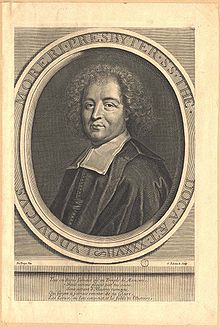Louis Moréri
Louis Moréri | |
|---|---|
 Louis Moréri, frontispiece, etching by Gerard Edelinck after a drawing by De Troyes, 17th century | |
| Born | 25 March 1643 |
| Died | 10 July 1680 (aged 38) |
Louis Moréri (25 March 1643 – 10 July 1680) was a French priest and encyclopaedist.
Life
Moréri was born in 1643 in Bargemon, a village in the ancient province of Provence, in the Diocese of Fréjus. His grandfather, Joseph Chatranet, a native of Dijon, had settled in Provence under King Charles IX of France and taken the name of the village of Moréri, the seigniory of which he had acquired through marriage.
Louis Moréri studied humanities in Draguignan and later rhetoric at the Jesuit College of Aix-en-Provence. He then studied theology and was ordained a priest in Lyon. During his stay in Lyon, he published several works, among them La pratique de la perfection chrétienne et religieuse (1667), a translation of the work of the noted Spanish Jesuit theologian, Alonso Rodriguez. It was probably in Lyon that he met Samuel Chappuzeau, who is said to have first given him the idea of writing his 'Dictionaire' or encyclopaedia.
In 1675 Moréri accompanied his bishop to Paris, where he became acquainted with Simon Arnauld, Marquis de Pomponne, then Secretary of State for Foreign Affairs, who gave him employment in his offices. After the downfall of that official in 1679, he returned to his studies, but overwork had undermined his constitution and he died in Paris of tuberculosis in 1680.
Legacy
Moréri's encyclopaedia, Le grand Dictionaire historique, ou le mélange curieux de l'histoire sacrée et profane (The Great Historical Dictionary, or Anthology of Sacred and Secular History) was first published in Lyon in 1674. The encyclopaedia focused particularly on historical and biographical articles. Moréri dedicated his encyclopaedia to Gaillard de Longjumeau, the Bishop of Apt, to whom he had been appointed chaplain. Moréri's one-volume edition of 1674 was revised by others after his death, each time it was published. It was translated into English, German, Italian, Dutch and Spanish. A total of at least 20 different editions were published between 1674 (one volume) and 1759 (10 volumes).
Pierre Bayle, author of the noted The Historical and Critical Dictionary (1697), intending to make up for what he felt were the deficiencies of Moréri's dictionary, said of him:
- I share the opinion of Horace on those who lead the way. The first compilers of dictionaries made many errors, but they deserve a glory of which their successors ought never to deprive them. Moréri has given himself a great deal of trouble, has been useful to everybody, and has sufficient information for many.

See also
References
 This article incorporates text from a publication now in the public domain: Herbermann, Charles, ed. (1913). "Louis Moréri". Catholic Encyclopedia. New York: Robert Appleton Company.
This article incorporates text from a publication now in the public domain: Herbermann, Charles, ed. (1913). "Louis Moréri". Catholic Encyclopedia. New York: Robert Appleton Company.
